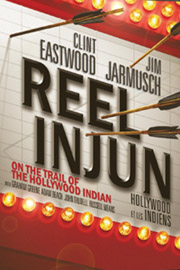| ________________
CM . . .
. Volume XVIII Number 1. . . .September 2, 2011
Being an native person who grew up in a First Nations community and attended both reserve and off-reserve schools, I've had many opportunities to reflect on how I perceived myself and, when I am feeling especially insecure, how others perceive me. What has marked these instances of self-awareness are the differences between how I feel as a native person and the degree to which I appear to others as a native person. Scholars of philosophy might suggest that this points to the notion that there are two principal types of identity: corporeal, that which is tactile and observable, and mentalistic, that which exists within ourselves as thoughts, beliefs, and notions of what should be. Reel Injun: On the Trail of the Hollywood Indian explores this struggle between bona fide indigeniety and how such indigeniety is manifest in tactile representations such as clothing, skin colour, and behaviour as represented in the film industry – particularly in America. In watching this film, I'm reminded of Sierra Adare's discussion on Hollywood films of the mid-twentieth century in her book "Indian" Stereotypes in TV Science Fiction where interviews with Native peoples revealed negative sentiments about the representation of native peoples:
It was sentiments like these that led Cree filmmaker Neil Diamond to create this documentary that takes him across America exploring the accuracy of Hollywood portrayals of Native peoples. In doing so, Diamond was met with numerous manifestations of indigenous knowledge, heritage and consciousness – a diversity that appears to stand in opposition to the broad stereotypes advanced in the film industry of the twentieth century. As Diamond shows with numerous examples from the era of silent movies to the mid-century westerns of John Wayne and Clint Eastwood, the stereotypical Indian was a Plains Indian who wore large feather headdresses, rode horses, consumed buffalo meat and demonstrated a sort of warrior spirit. As many of the communities Diamond visited exemplified, these stereotypes were frequently unrepresentative of many First Nations. One of the phenomena associated with the Hollywood stereotypes explored by Diamond, of which some of the interviewees in the film regarded as "funny", was that of stereotypical Indians being portrayed by non-indigenous actors. With red body-paint and practiced accents, these portrayals have exasperated the problematic representation of American Indians through the objectification of the North American indigenous experience.
Recommended. Frank Deer is an assistant professor in the Faculty of Education, University of Manitoba.
To comment
on this title or this review, send mail to cm@umanitoba.ca.
Copyright © the Manitoba Library Association. Reproduction for personal
use is permitted only if this copyright notice is maintained. Any
other reproduction is prohibited without permission.
NEXT REVIEW |
TABLE OF CONTENTS FOR THIS ISSUE
- September 2, 2011May 20, 2011.
AUTHORS |
TITLES |
MEDIA REVIEWS |
PROFILES |
BACK ISSUES |
SEARCH |
CMARCHIVE |
HOME |
